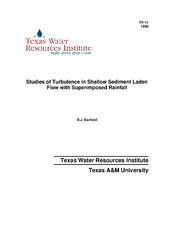| dc.creator | Barfield, B. J. | |
| dc.date.accessioned | 2011-06-30T14:37:45Z | |
| dc.date.available | 2011-06-30T14:37:45Z | |
| dc.date.issued | 1968-01 | |
| dc.identifier.uri | https://hdl.handle.net/1969.1/94853 | |
| dc.description.abstract | The structure of turbulence has been shown to affect the sediment carrying capability of streams. Due to the random nature of turbulence, sediment movement was analyzed as a stochastic process. Starting with the Langevin equation modified for a turbulent medium, a partial differential equation was developed as a mathematical model which describes the change in sediment concentration with time and space for two dimensional open channel flow with isotropic turbulence. The input parameters to the partial differential equation were the particle fall velocity and the turbulent diffusion coefficient. The diffusion coefficient used was the product of the mean square velocity and the Eulerian time scale of turbulence.
A 4O ft. recirculating research flume was used for the experimental investigations. The RMS velocity and Eulerian time scale profiles were determined by use of a hot-film anemometer and a random signal correlator. The effect of rainfall on the RMS velocities and time scale profiles was observed. Sediment concentration profiles were measured by withdrawing samples from the flow and were compared with values predicted by the derived mathematical model. | en |
| dc.language.iso | en_US | |
| dc.publisher | Texas Water Resources Institute | |
| dc.relation.ispartofseries | TR;11 | |
| dc.title | Studies of Turbulence in Shallow Sediment Laden Flow With Superimposed Rainfall | en |
| dc.type | Technical Report | en |


